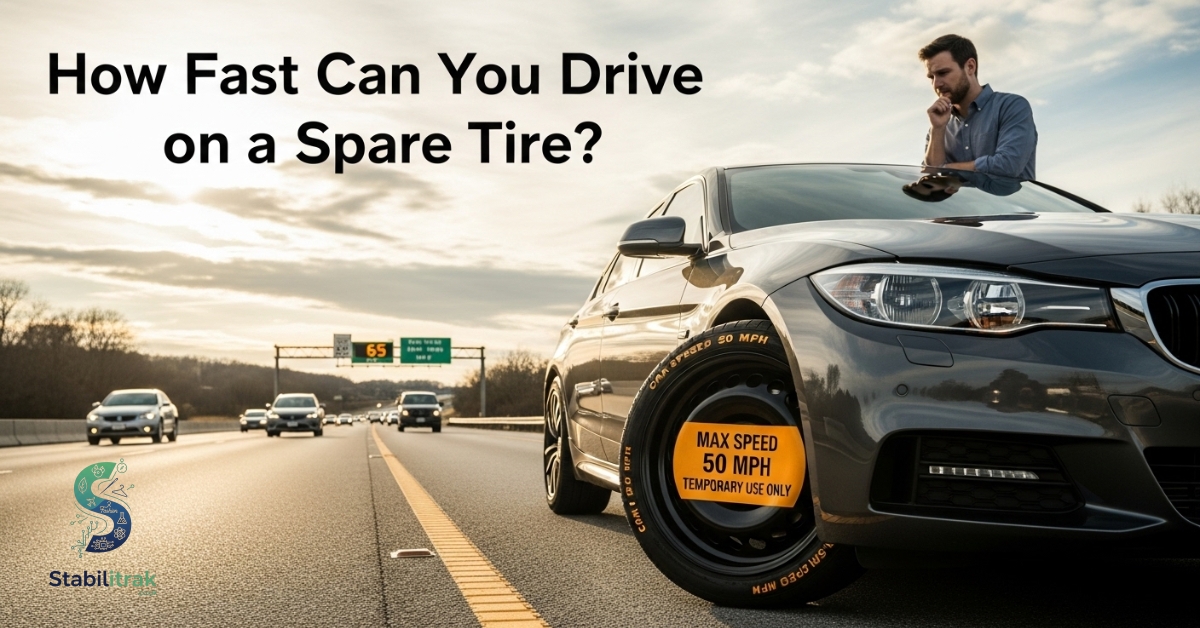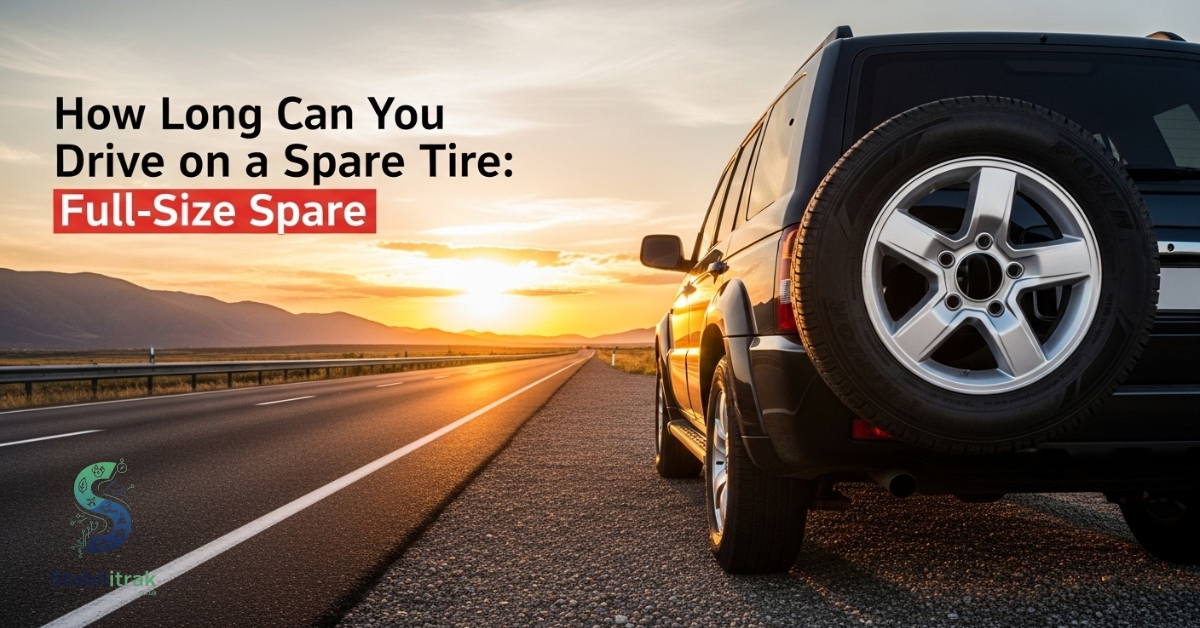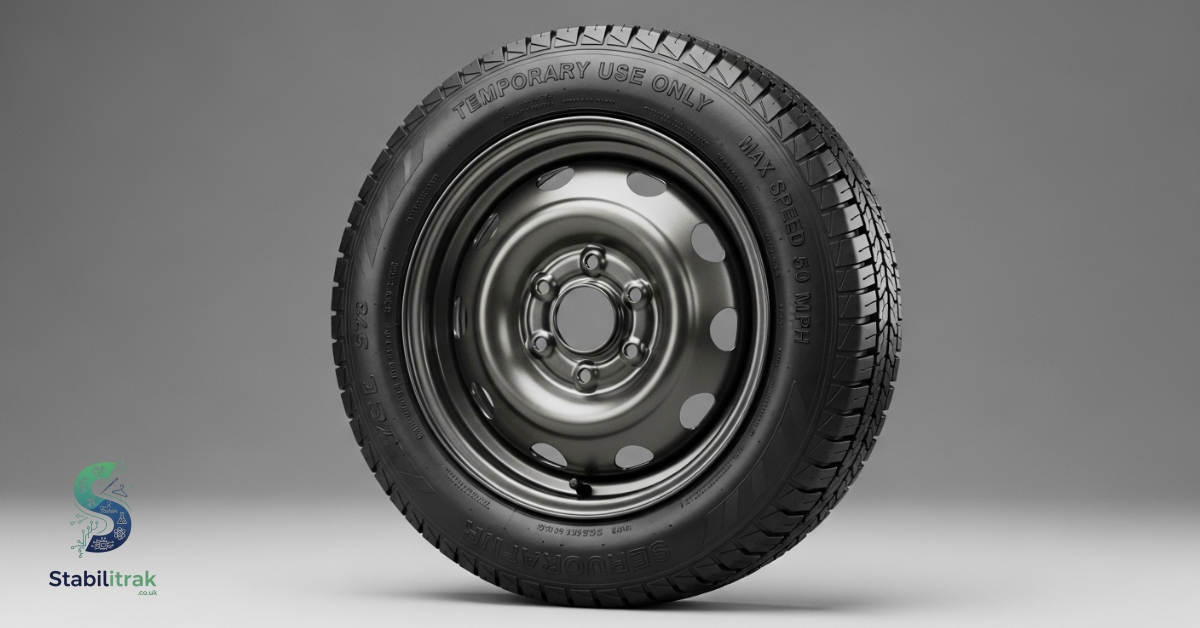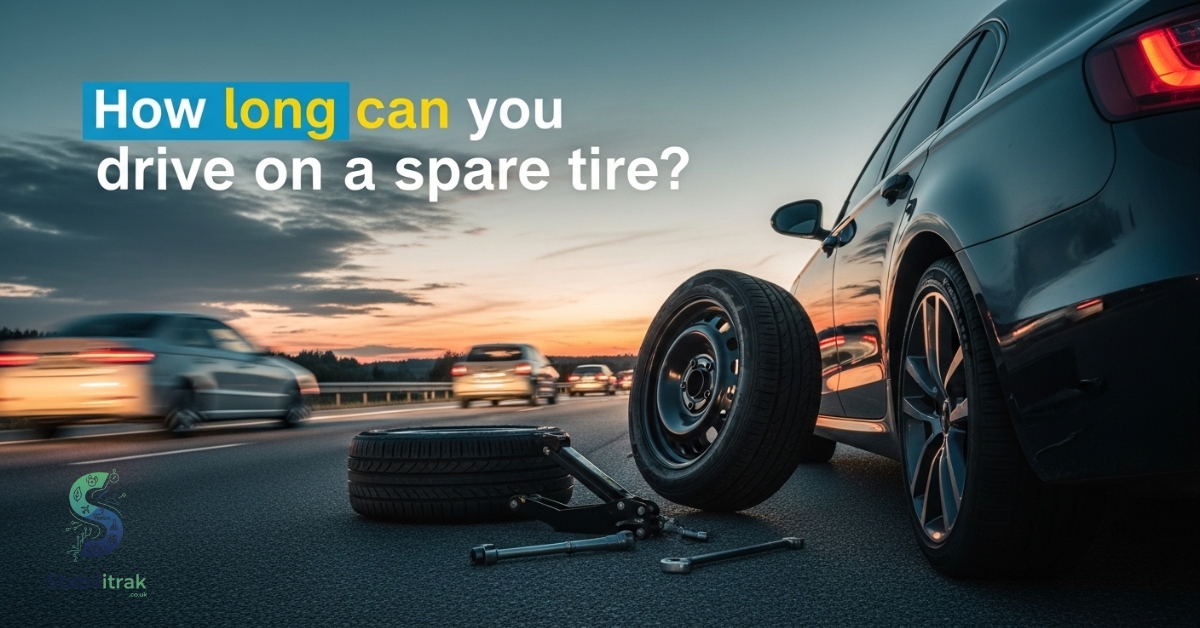You never really think about your spare tire until you suddenly need it. One minute you’re driving without a care, and the next you’re pulled over with a flat, staring at that little donut spare in your trunk and wondering if it can really get you where you need to go. Should you risk driving more than 50 miles on it? Is it safe to push past 50 mph? It’s frustrating and stressful, especially if you’re not sure about the limits of your compact spare or full-size backup.
That’s exactly what this post will clear up. We’ll walk you through the types of spare tires, explain how far and how fast you can safely drive on each, and cover the risks of overextending their use. By the end, you’ll know the real limits of your spare tire and the smart steps to take so you can get back on the road with confidence.
Safe Driving on Spare Tires: How Far and Fast Can You Drive on a Spare Tire?
When you’re stuck with a flat, the first question is usually about distance. A compact spare, often called a donut spare, is only designed for temporary use. Most manufacturers recommend limiting it to 50 miles at speeds no higher than 50 mph. It’s basically a short-term solution to get you safely to a repair shop, not something meant for long highway travel.
A full-size spare works differently. If it matches your regular tires, you can drive on it much longer, sometimes until your next scheduled tire replacement. But even then, it’s best to treat it as a temporary fix. The tread depth, tire wear, or brand differences can affect vehicle handling and cause uneven wear over time.
Read More Article: How Much to Tint Car Windows
Can You Drive on a Flat Tire?

Driving on a completely flat tire is never safe. Not only does it destroy the tire itself, but it can also damage the wheel rim, affect your suspension, and throw off your brake system. Even moving a short distance, like to the next exit, can turn a simple puncture repair into a costly replacement of both the tire and wheel.
If you notice a flat, pull over to a safe location, turn on your hazard lights, and install your spare right away. Think of the spare as your lifeline; it keeps you moving, but only within limits.
How Long Can You Drive on a Spare Tire?
This is the big question. If you’re using a compact temporary spare, remember the “50/50 rule”: no more than 50 miles, no faster than 50 mph. It might seem restrictive, but it’s meant to protect you from risks like blowouts, poor traction, and even speedometer inaccuracies.
With a full-size spare, you technically have more flexibility. Some drivers continue for weeks, but this isn’t ideal. Over time, mismatched tread patterns and tire wear can lead to handling problems. For safety, plan to replace or repair your damaged tire as soon as possible, ideally within a few days.
How Fast Can You Drive on a Spare Tire?

Speed limits on spare tires aren’t about legal rules; they’re about physics. A donut spare has less tread, less width, and often higher tire pressure than your regular tires. Push it past 50 mph, and you increase your chances of traction loss, hydroplaning, or even a blowout.
A full-size spare lets you drive at normal speeds, but there’s still a catch. If the spare isn’t the same size or brand, it may affect your anti-lock brake system (ABS) or create extra stress on your drivetrain. Sticking to moderate speeds until you get a proper replacement is the smart move.
How to Drive Safely on a Spare Tire
Once you’ve installed the spare, adjust your driving habits. Avoid sharp turns, sudden braking, and long highway trips. The reduced tire traction makes your car less stable in slippery conditions like rain or puddles. Leave extra space between you and the car ahead to allow for longer braking distances.
Always check tire inflation pressure before you drive away. Many spares sit unused for years in the trunk and may have lost air. If your manual recommends 60 PSI for the donut spare, make sure it’s topped up. Underinflated spares are dangerous.
Stay Safe and Be Prepared with Top Driver
The best way to avoid panic during a flat tire is preparation. Keep your owner’s manual handy, know where your spare is stored, and practice changing it at home. If you’re new to driving, enrolling in driver education or in-vehicle training can give you hands-on practice in a safe environment.
Companies like Top Driver and other driving schools often include tire safety and roadside emergency lessons in their programs. Learning these skills before an actual emergency helps you stay calm and in control when it counts.
How Long Can I Drive on a Spare Tire?
If your car came with a compact spare, remember that it’s designed to save space, not to serve as a permanent fix. Treat it like a band-aid, something that works temporarily but shouldn’t replace the real thing.
For a full-size spare, you can relax a little more. It behaves like your normal tire, but still plan for a tire repair or replacement soon. Even if it feels fine, relying on it for too long can shorten your vehicle’s overall tire lifespan.
How Long Can You Drive on a Spare Tire: Space-Saver Spare
The space-saver spare, also called a donut, is the most restrictive option. Its smaller size and limited tread make it less stable. Driving beyond 50 miles or exceeding 50 mph raises the risk of a blowout, poor vehicle handling, or even issues with your suspension system.
If you have to use one, stick to local roads rather than highways. Think of it as a tool to get you from point A (where you had the flat) to point B (the repair shop or service center).
How Long Can You Drive on a Spare Tire: Full-Size Spare

A full-size spare is much safer for longer distances. If it’s the same make and model as your other tires, you can often drive normally until you get the damaged tire repaired. Many SUVs and trucks come equipped with these for extra safety.
The only caution is tire rotation and wear. If your spare has been sitting unused for years, it may not match the tread depth of your other tires. Driving with mismatched tread can affect road safety, especially in wet conditions.
What is a Run-Flat Tire?
Run-flat tires are a modern alternative to carrying a spare. They’re built with reinforced sidewalls that allow you to drive about 50 to 70 miles at reduced speeds, even after a puncture. That gives you more flexibility to find a service center without changing a tire on the roadside.
However, run-flats aren’t perfect. They tend to be more expensive, can’t always be repaired, and may deliver a stiffer ride. Still, they eliminate the hassle of pulling over on a dark road to swap a tire.
Rely On Sid Dillon Hyundai for More Tire Care Advice
If you’re unsure about your tire’s condition, don’t guess; ask the experts. Service centers like Sid Dillon Hyundai offer tire inspections, replacements, and tire care programs that keep you safe. They can also check your brake system, wheel alignment, and suspension during the same visit.
Building a relationship with a trusted service center ensures you’re never left stranded. They’ll help you understand manufacturer recommendations, handle tire rotation tips, and keep track of your tire quality over the years.
How Long Can You Drive on a Spare Tire in Turnersville?
Local driving conditions matter. If you’re in Turnersville or nearby towns, short commutes on local roads may feel safe with a compact spare. But keep in mind, potholes and sharp turns put extra stress on a donut spare.
Even in familiar areas like Sewell or Williamstown, your best bet is to head directly to a repair shop or service center. Delaying tire replacement increases the risk of a roadside breakdown.
Understanding Spare Tires
Not all spares are created equal. Some vehicles have a compact donut, others carry a full-size spare, and newer models may not include one at all. Instead, they come with a tire repair kit or run-flats.
Check your owner’s manual to know exactly what you have. Don’t wait until an emergency to find out whether your spare is usable.
Full-Size Spare Tires
These are the gold standard of spare solutions. If properly inflated and stored, they function almost the same as your regular tire. But be mindful of age deterioration. Even if it’s unused, a tire older than six to ten years may not be safe.
A quick tire inspection at a service center can confirm whether your full-size spare is roadworthy. If not, replace it before you need it.
Compact Temporary Spare Tires
Compact spares are designed for convenience. They’re lighter, take up less trunk space, and keep car weight down for better fuel economy. But all those benefits come with serious tire limitations.
Using one for long distances reduces your car’s performance and can put stress on the drivetrain. Stick to short trips only.
How Long Can You Drive on a Spare Tire?
To recap:
- Compact donut/space-saver: 50 miles, 50 mph max
- Full-size spare: longer, but replace ASAP
- Run-flat tire: 50 to 70 miles at reduced speeds
Treat every spare as temporary. The sooner you get the damaged tire fixed, the safer you’ll be.
Full-Size Spare Tire
If you’re lucky enough to have a full-size spare, remember to maintain it like your other tires. That means tire pressure checks, rotation, and inspection for tire tread wear. Many drivers ignore their spare until an emergency, only to find it unusable.
Adding your spare to your tire care routine ensures it’s ready when you need it most.
Compact Temporary Spare Tire
This little lifesaver is exactly that: temporary. Think of it as an umbrella in the rain: useful, but you wouldn’t want to rely on it every day. The reduced traction and stability mean it’s only safe for short-term use.
Make sure it’s inflated properly (often around 60 PSI). Driving on an underinflated donut is dangerous and may cause sudden failure.
Tips for Driving on a Spare Tire
- Avoid highways and long-distance travel
- Keep your speed under control
- Check the spare tire pressure before every trip
- Don’t overload your car with heavy cargo
- Visit a repair shop or service center right away
Read More Article: How Long Does an Alignment Take?
Space-Saver Spare Tires aka “Donut” Spare Tires

The donut spare is designed with one purpose: to get you safely to a service center. It’s lighter and cheaper but far less durable. Because of its small size, it can throw off your speedometer readings and affect braking balance.
If you’re in an emergency, it’s fine. Just don’t treat it like a long-term solution.
Benefits of a Full-Size Spare
A full-size spare gives peace of mind. It keeps your vehicle handling consistent, allows you to maintain highway speeds, and reduces the urgency of immediate tire replacement.
However, it does take up more trunk space and adds weight to your car. Many modern sedans skip them in favor of smaller spares or repair kits.
Run-Flat Tire Performance
Run-flats are great for convenience, but they do have tire limitations. They’re not meant for long-term use once punctured. After the 50 to 70-mile window, you must replace or repair them.
Also, run-flats don’t always give the same smooth ride. Some drivers notice more road noise and stiffness compared to standard tires.
Get Tire Repairs and Replacements at Audi Fletcher Jones
If you drive an Audi or similar vehicle, genuine tire care is essential. Authorized centers like Audi Fletcher Jones provide genuine Audi tires, expert installation, and matching tire programs. They also offer service coupons and maintenance packages to keep costs in check.
Investing in proper care saves you from future breakdowns and ensures your car performs at its best.
Schedule Tire Replacement Service at Audi Fletcher Jones Today
Don’t wait until you’re stuck on the roadside with a flat. Schedule a tire inspection or replacement ahead of time. Whether you need a new set of tires or just want peace of mind, their team can help.
A little proactive care today prevents big headaches tomorrow.
How Long Can You Drive on a Spare Tire?
Once more for clarity:
- Donut/compact: 50 miles, 50 mph
- Full-size spare: longer, but still temporary
- Run-flats: 50 to 70 miles after a puncture
The golden rule? Always treat your spare as a bridge, not a destination.
How Long Can I Drive on a Spare Tire? – Space-Saver Spare
If you’ve got a space-saver spare, don’t risk pushing it. Beyond 50 miles, you’re gambling with your safety. Stick to short drives to your local repair shop.
How Long Can I Drive on a Spare Tire? – Full-Sized Spare
A full-sized spare feels just like your normal tire, but remember it’s not always the same brand or tread depth. Schedule a replacement soon to avoid long-term issues with vehicle performance.
How Long Can I Drive on a Spare Tire? – Run-Flat Tires
Run-flats give you more flexibility, but they still have a limit. After about 50–70 miles, the structural support weakens. Plan and head straight to a service center.
Conclusion
A flat tire is an inconvenience, but knowing your options keeps you safe. Whether you have a compact spare, a full-size spare, or run-flats, the key is to treat them as temporary fixes. Stick to the mileage and speed guidelines, adjust your driving, and head to a repair shop as soon as possible.
By maintaining your spare tire, checking its pressure, and learning how to use it, you’ll always be prepared. A little knowledge goes a long way in preventing a roadside emergency from turning into a major disruption.
FAQs
Can I drive on a spare tire for 2 days?
If it’s a compact donut spare, no, it’s only safe for about 50 miles. A full-size spare can last longer, but it’s still recommended to replace it as soon as possible.
Can I drive on a spare tire for a week?
A donut spare won’t last a week. A full-size spare might, but it’s not recommended because a mismatched tread or wear can affect your car’s handling.
Can I drive on a spare tire for 3 days?
Three days on a donut spare is pushing it. Stick to the 50/50 rule (50 miles, 50 mph) and get to a repair shop quickly.
Can I drive on a spare tire for 2 weeks?
Two weeks is far too long for a donut spare. Even with a full-size spare, you should replace or repair your damaged tire much sooner.
How long can you drive on a spare tire, Reddit?
Reddit users often mention the 50/50 guideline for donuts and longer use for full-size spares. But the safest advice is always to treat any spare as temporary.
Can I drive 200 miles on a donut?
No, a donut spare is only designed for about 50 miles. Driving 200 miles risks a blowout and serious damage to your car.
How fast can you drive on a spare tire?
With a donut spare, stay under 50 mph. A full-size spare lets you drive faster, but it’s still best to avoid highway speeds until you get a replacement.
Can I drive on a spare tire for 4 days?
Four days is too long for a donut spare. Use it only to reach a service center and get a new tire installed.
What happens if you drive 200 miles on a spare tire?
The spare could overheat, lose traction, or fail. It also puts stress on your suspension and brakes.
What happens if you drive more than 70 miles on a spare tire?
Going past 70 miles on a donut raises the risk of a blowout. Even if it doesn’t fail, it can damage your car’s handling systems.
Can I drive on a highway with a spare tire?
You can, but only briefly and at reduced speeds. High speeds put too much strain on donut spares.
Can you drive on a spare tire in the rain?
Yes, but be extra cautious. Donut spares have less tread, so they’re more likely to lose traction or hydroplane in wet conditions.


1 thought on “How Long Can You Drive on a Spare Tire?”